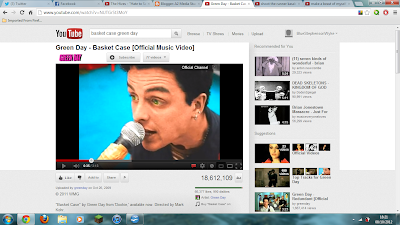Codes
and Conventions of selected brief
Every genre of music video has its own codes and conventions; these
expected and predictable signs are read by an audience which then
allows them to differentiate between media texts and identify
specific genres. There are four main types of form in which music
videos can be categorised, these are: performance, narrative,
animated and abstract.
For my chosen brief, I have chosen the song “Going to Hell” by
alternative rock band the Brian Jonestown Massacre who are signed to
an independent record label. Therefore, as research to give me a
greater understanding of the typical codes and conventions of the
alternative genre, I looked at existing music videos and how such
techniques are used within the form.
For alternative music, the most frequent and conventional form of
video is a performance-related one which shows the band playing.
However, whilst the cinematography used in such videos generally
stays the same, the choice of mise en scene for many performance
videos is always changing and quite often the band will be shown
playing in an unusual location which makes the video memorable, e.g.
Smells Like Teen Spirit by Nirvana in a school hall and Basket Case
by Green Day which takes place in a mental asylum. The alternative
rock genre stays dynamic because bands are always attempting to be
more innovative with the use of location within their videos.
Illustration
1: This shot from the Basket Case video shows a close up shot of the
singer and microphone which is a conventional feature of the genre.
An animated form of music video is less traditional of the genre, but
can be quite effective as it goes against the audience expectation.
“Shoot the Runner” by Kasabian is a good example of an animated
video that still maintains the conventional cinematography and
editing techniques of the genre.
Illustration
2: "Shoot the Runner" by Kasabian, showing an animated
version of the band performing in a long shot.
The technical codes used within the genre such as its camera
techniques serve to meet the audience expectations as they generally
follow a set of rules. A variety of camera shots within a performance
or montage video can keep it dynamic and interesting even if the
performers are static. Within my chosen genre, medium close up shots
and close up shots are used the most prominently as they show us and
therefore allow us to identify the artists performing; this also
can create a sense of intimacy between the audience and the performer
they are viewing. Long shots are also used to capture the whole band in
the shot and such shots are used less frequently; often interweaving
with the other medium and close up shots. However, these camera
techniques can differ between genres, for example a long shot or wide
shot may be used more prominently within a video that features
dancers as it allows us to experience it as a performance spectacle.
Close up shots of guitar strings or a guitar being strummed are also
quite common within the genre.
Illustration
3: In the "Make a Beast of Myself" video, the singer is
filmed in one continuous tracking shot throughout.
Tracking shots can also be used within performance-related music
videos as they create fluidity and are able to capture the whole band
within the shot, however they are more conventional within videos
that follow a narrative; particularly ones where the artist or
performer is moving or travelling somewhere, for example within the
“Make a Beast of Myself” video by Twin Atlantic.
The use of editing can differ between genres. Within alternative
videos, quick cuts are always used in favour of fades or transitions
as they allow for a video to use a range of different camera shots
and the use of editing can serve to accentuate the pace of the song. Music videos are generally highly mimetic, and if a particular video features lip-syncing, then it will be
edited in such a way that it appears seamless. Sometimes, a band's music video will be
presented through a montage sequence which typically includes a range
of different footage from a band's live performances along with other
footage, edited together using quick cuts.
Because the performers in a music video are usually filling the roles
of themselves, e.g. the singer, guitarist, bass player, drummer, they
have become conventional characters. The dress codes of the band
members usually reflect how they would dress normally unless the band
has a particular coordinated look, such as The Hives who all wear
white or black suits.
Illustration 4: This image from the song "Hate to Say I Told You So" by The Hives shows the band member all wearing matching black suits with white ties.
Illustration 4: This image from the song "Hate to Say I Told You So" by The Hives shows the band member all wearing matching black suits with white ties.
All of these codes and conventions are used to fulfill the audience's
expectation of the genre, this means that music videos, just like all
other media texts, are ideological texts which we the audience read in
terms of our own ideologies. I am undecided as to the form in which I
will present my own music video, however I will take into
consideration when filming and editing, the codes and conventions of
the genre and then decide whether I will use these or in fact work
against them.




No comments:
Post a Comment